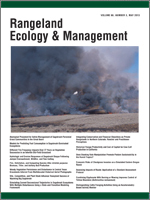Disturbances and their interactions play major roles in sagebrush (Artemisia spp. L.) community dynamics. Although impacts of some disturbances, most notably fire, have been quantified at the landscape level, some have been ignored and rarely are interactions between disturbances evaluated. We developed conceptual state-and-transition models for each of two broad sagebrush groups—a warm-dry group characterized by Wyoming big sagebrush (Artemisia tridentata Nutt. subsp. wyomingensis Beetle & Young) communities and a cool-moist group characterized by mountain big sagebrush (Artemisia tridentata Nutt. subsp. vaseyana [Rydb.] Beetle) communities. We used the Vegetation Dynamics Development Tool to explore how the abundance of community phases and states in each conceptual model might be affected by fire, insect outbreak, drought, snow mold, voles, sudden drops in winter temperatures (freeze-kill), livestock grazing, juniper (Juniperus occidentalis var. occidentalis Hook.) expansion, nonnative annual grasses such as cheatgrass (Bromus tectorum L.), and vegetation treatments. Changes in fuel continuity and loading resulted in average fire rotations of 12 yr in the warm-dry sagebrush group and 81 yr in the cool-moist sagebrush group. Model results in the warm-dry sagebrush group indicated postfire seeding success alone was not sufficient to limit the area of cheatgrass domination. The frequency of episodes of very high utilization by domestic livestock during severe drought was a key influence on community phase abundance in our models. In the cool-moist sagebrush group, model results indicated at least 10% of the juniper expansion area should be treated annually to keep juniper in check. Regardless, juniper seedlings and saplings would remain abundant.
How to translate text using browser tools
1 May 2013
Simulating Current Successional Trajectories in Sagebrush Ecosystems With Multiple Disturbances Using a State-and-Transition Modeling Framework
Louisa B. Evers,
Richard F. Miller,
Paul S. Doescher,
Miles Hemstrom,
Ronald P. Neilson
ACCESS THE FULL ARTICLE

Rangeland Ecology and Management
Vol. 66 • No. 3
May 2013
Vol. 66 • No. 3
May 2013
annual grasses
juniper
livestock grazing
Vegetation Dynamics Development Tool
vegetation treatments




